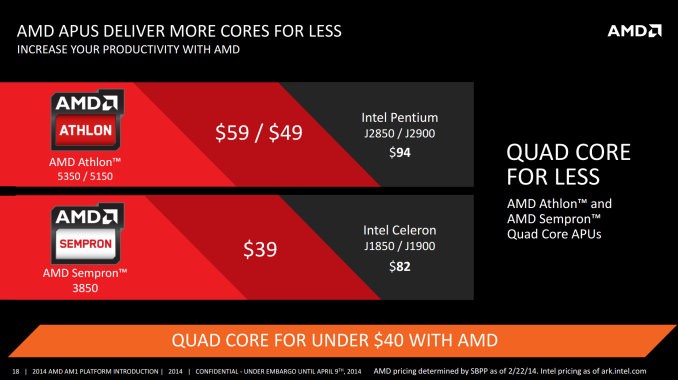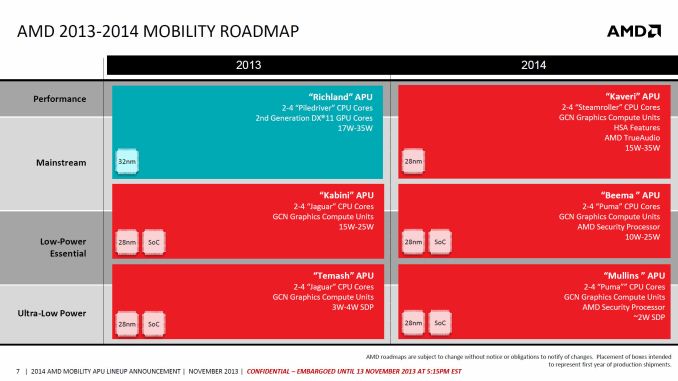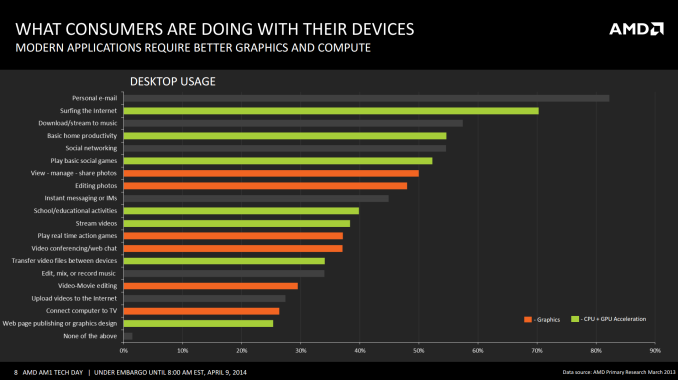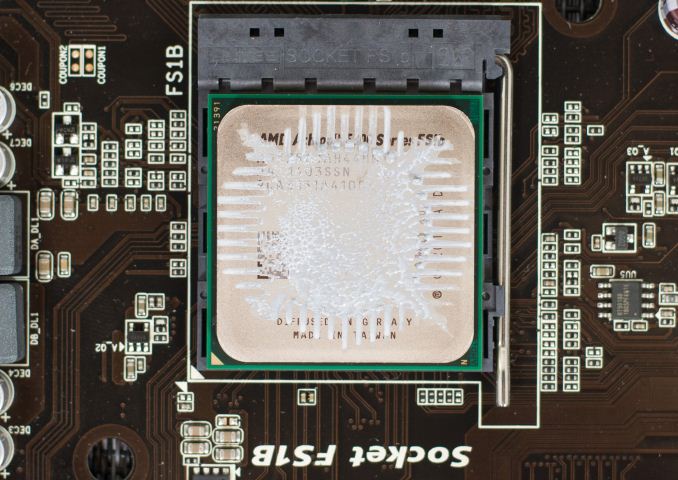The Desktop Kabini Review Part 1: AMD Athlon 5350 (AM1) Tested
by Ian Cutress on April 9, 2014 8:00 AM ESTFinal Words
As mentioned in our test setup, the benchmark results in this preliminary article are only a small fraction of our normal coverage. Due to other commitments we were unable to run every test on all comparison systems, but we have the other Athlon and Sempron APUs as well as comparable Intel counterparts coming in for review.
The poignant place to start with the final analysis is AMD’s claim of ‘Quad Core for Less’. In this statement alone, they are not wrong. Intel cannot provide a socketed quad core processor for less than $36 (Sempron 3850). The cheapest all-in-one desktop quad-core system from Intel equips the Celeron J1900 onto a motherboard for $92, which is exactly where AMD sit with the top-end Kabini based Athlon 5350 with a motherboard. One of the issues to consider at this point however is that Intel offers several dual core options (non-Atom) around this $40-$60 price point, and in many cases the IPC and CPU speed advantage of these cores is greater than that provided by Kabini, particularly in single threaded applications. The only downsides to this solution are the power consumption is higher, and the motherboards are more expensive. For a competitive socketed Intel dual core, a motherboard plus CPU can be in the region of $110-$120 at 35W-55W.
The big upside and selling point from the AM1 Kabini platform should be upgradeability. If a user buys an AM1 platform now, they should be able to upgrade it in the future. While AMD has not yet confirmed if Beema is coming to the socketed platform, the roadmaps suggest that the laptop sockets are remaining consistent from Kabini to Beema. This should imply that if Beema gets a socketed version, it should also remain based on AM1/FS1b.
If we compare single threaded performance between Kabini and our J1800 test system, the benchmarks are almost even between the two, particularly when it comes to synthetics such as Cinebench, but falls behind on emulation such as the Dolphin Benchmark and 3DPM. The integrated graphics of the Kabini pull ahead when it comes to gaming, despite the single channel memory interface.
|
AMD Athlon 5350 vs. Intel Celeron J1800 Single Threaded |
||
| Athlon 5350 | Celeron J1800 | |
| Cinebench R10 | 1967 | 1917 |
| Cinebench R11.5 | 0.51 | 0.49 |
| Dolphin Benchmark | 40.4 | 38.02 |
| 3DPM | 53.29 | 69.20 |
When placing Kabini against any Intel Ivy Bridge socketed processor, the increased IPC and frequency pushes the system above the Kabini, in exchange for more power and a more expensive system overall. If we compare the Kabini single-threaded results to those of the Celeron G465, a Sandy Bridge based single core CPU at 1.9 GHz, the Celeron does pull ahead on the majority, but fails miserably in the graphical benchmark suite.
|
AMD Athlon 5350 vs. Intel Celeron G465 Single Threaded |
||
| Athlon 5350 | Celeron G465 | |
| Cinebench R10 | 1967 | 2975 |
| Cinebench R11.5 | 0.51 | 0.73 |
| Dolphin Benchmark | 40.4 | 38.8 |
| 3DPM | 53.29 | 59.98 |
Does it seem particularly odd that a modern Kabini architecture at 2 GHz cannot keep up with a 3 year old Sandy Bridge processor at 1.9 GHz at our simple benchmarks? AMD is leveraging on the fact that much of what we do on a computer as a casual user can leverage the fixed function units of the graphics center of the APU:
AMD’s key in all of this is leveraging the GPU. For non-GPU intensive tasks, on paper, the J1900 for $92 and 10W TDP would seem to be the choice if upgradability is not a concern. The remit of AM1 and Kabini could be extended if motherboard manufacturers decided to use those extra PCIe lanes. Consider an AM1 with controllers to make a nice routing system (4x NIC) or something based around storage (SATA controllers and hubs). But because Kabini is also a cost play for AMD at the low-end desktop segment, margins are going to be ultra-tight for motherboard manufacturers and I do not imagine that as much effort will be put into making innovative products as the rest of their product range on other sockets.
In order for the upgradability angle to work, AMD need to keep the sockets around for at least two generations. AM1 comes late in Kabini’s life cycle, given that Beema on the mobile side is due out later in 2014. It would make sense for AMD to release Beema desktop parts, but the big question there is when. AMD could launch new processors on day 1 of Beema, or further into the life cycle. I would imagine that depends on what the competition does. AMD does have that advantage of having an upgradeable platform before Intel; however Intel may see the market differently. It is a hard one to judge.
Stay tuned for our full benchmark suite on the other AMD Kabini APUs.














126 Comments
View All Comments
ozzuneoj86 - Wednesday, April 9, 2014 - link
I do hope that all of this works out for AMD. It seems like a pretty huge gamble to invest so much time and energy into creating a new socketed platform. I do like the idea of tiny yet powerful systems, for sure. I built a Pentium 4 based mini-ITX system that won Maximum PC's rig of the month in July 2007, since there were relatively few ITX systems available at the time. This was pre-Atom, so you were either spending $300+ on a board that took an equally expensive Core-based laptop CPU, or you were going with a Via C7 or some other abysmally slow chip built into a board that still cost $200. Our grand total for the whole project was under $500.That system is socketed, but with Intel Extreme 2 graphics (before GMA) and only a PCI slot to work with, there was only so much it could be used for. It handles emulators perfectly fine though.
Anyway, I just hope they hang on to this platform for a while so that it makes sense for it to be socketed. Looking at the CPU options available, it doesn't look like it offers a huge range of possibilities. They are all quite firmly seated in the low end of performance and aren't all that power efficient. I could see a low end platform being useful if they offered significantly different combinations of CPU power, GPU power and wattages, but I'm not really seeing that with these.
ozzuneoj86 - Wednesday, April 9, 2014 - link
For clarification, by "not all that power efficient" I mean the TDP, when compared to Intel's non-socketed chips. These are still fairly low wattage, but you can't exactly stuff one of these in a cigar box and run in passively cooled.Also, any chance we could get a Celeron 1037u system benchmarked as well? I'm curious as to how the CPU\GPU performance compares to the J series, as well as Kabini. http://ark.intel.com/products/71995
Hardened - Thursday, April 10, 2014 - link
I woul like to support request for comparison with Celeron 1037U. It is a very interesting CPU performance and cost wise. Gigabyte GA-1037UN mobo is also a very nice offer with 2x LAN and eSATA ports all under 90 USD.Computer Bottleneck - Wednesday, April 9, 2014 - link
Do we know if any manufacturers will be supporting ECC RAM on these boards? Or any upcoming AM1 boards?According to CPU World Athlon 5350 does indeed support ECC:
http://www.cpu-world.com/CPUs/Jaguar/AMD-Athlon%20...
TheCrustyCupcake - Wednesday, April 9, 2014 - link
Water cooled AM1 socket-ed APU's anyone? If overclocking was available I could see an EVGA super ultra FTW edition AM1 motherboard with an 8-pin supplemental CPU power connector, and crossfire support!DudemanX - Wednesday, April 9, 2014 - link
In part 2 and in future articles when reviewing IGPs, can you do some game benchmarks at more mainstream resolutions(1680, 1920, maybe even 1440) but with "Low" quality settings? Many might disagree but not running my display at native resolution is one of the last compromises I make when using inadequate hardware. I understand these aren't mainstream chips but they are desktop/media center chips. Do people really buy desktop monitors/TVs lower than 1680 these days? Certainly no one's running games in 4:3 anymore, are they?mariush - Wednesday, April 9, 2014 - link
I just don't understand why they don't make the boards for these systems to run on 12-19v laptop adapter type power supplies.It's really not that expensive to add a dc-dc converter on the motherboard to make 5v for the sata drives and onboard stuff... no, we still have to use a big fat 24pin atx cable AND a 4 pin cpu cable for a system that uses 30-60 watts (without a powerful video card).
srkelley - Wednesday, April 9, 2014 - link
Can you post some modified benchmarks of the gaming performance please? I'm interested in seeing the average frame rate of the same games but run with Medium settings at 1280x720 please. It doesn't need to be in a fancy chart or done completely scientifically, just a few numbers would be helpful!shady28 - Thursday, April 10, 2014 - link
Great review, this helps clear up some questions regarding AM1.Suggestion for your follow up -
If possible, show more of the chips this succeeds and that it competes against.
ie :
J1800, J1900, 3770, and some of the older Atoms like D525 or D510.
It would also be interesting to see a couple of older reference desktop, like a P4 D chip. For some this would help answer the question, is this a viable upgrade for someone who wants a small low power replacement for an old power hog of a P4?
The obligatory i5-2500k or i5-3570k is fine, but stacking up a huge number of 100W chips in the comparison doesn't help, it just clutters up the charts with products that in no way compete with something like Kabini.
Penti - Thursday, April 10, 2014 - link
So it's a Kabini/Jaguar fabbed at Global Foundries in Germany? Why?